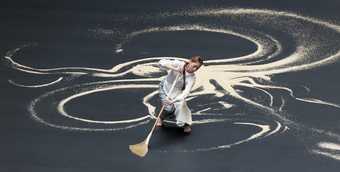Introduction
Lee Mingwei creates artworks, often in the form of performances or interactive works, which allow audiences to experience chance encounters and spaces for deep reflection. Our Labyrinth creates a space of ritual and sacredness within the museum. It centres on dancers mindfully brushing a mound of rice into labyrinthine patterns. They are guided by rice as they perform for the duration of the museum’s opening hours for 21 days.
Our Labyrinth is an impermanent artwork staged in different locations and contexts, yet consistent themes and questions are raised. Lee and the performers creating the artwork often describe it as a ‘gift’ to audiences, but how can a dance be a gift? The dancers are instructed to be ‘guided by the rice’ yet there’s no choreography. How do the dancers know which steps to take? Underpinning the specifics of Our Labyrinth is Lee’s question towards his wider practice: ‘Can art be made out of attention itself?’
By exploring these questions, Our Labyrinth reveals Lee’s exploration of beauty and chance through impermanent encounters.
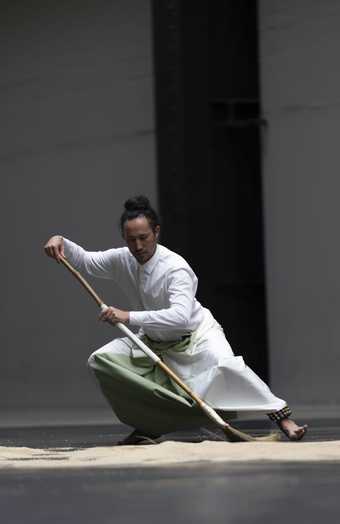
The seed dancer Jean-Gabriel Manolis creates his movement through being guided by the rice.
Lee Mingwei, Our Labyrinth, 2015-ongoing. Performance view at Tate Modern, 2022. Photograph © Tate 2022 (Photographer: Oliver Cowling)
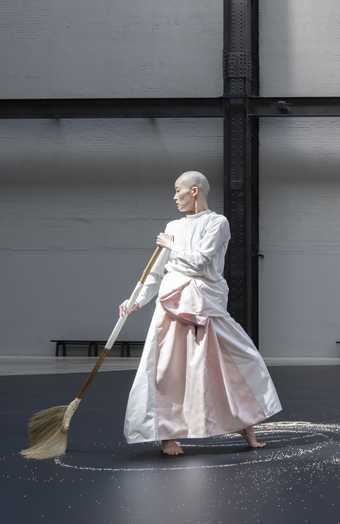
A shard of light catches Liu I-Ling as she sweeps the rice in the Turbine Hall.
Lee Mingwei, Our Labyrinth, 2015-ongoing. Performance view at Tate Modern, 2022. Photograph © Tate 2022 (Photographer: Oliver Cowling)
Our Labyrinth
The origins of Our Labyrinth began in 2014 when Lee travelled to Myanmar. There he visited ancient temples in the countryside where visitors would take off their shoes before entering sacred spaces. Lee marvelled at how well kept the spaces were. He learned volunteers from the community swept the paths clean as an offering to visitors they may never met. Lee explains ‘it was not only a gesture of physical cleaning - it was also a way to feel spiritually and emotionally cleansed. When I came back, I thought I wanted to bring that sense of sacredness, of ritual and beauty, into the museum.'
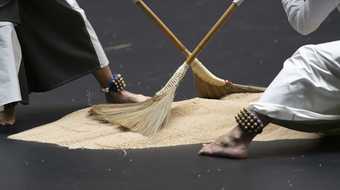
The dancers perform with carefully selected props – rice, brooms, silk sarongs and ankle bells – each symbolic of the ritual Lee Mingwei creates in Our Labyrinth.
Lee Mingwei, Our Labyrinth, 2015-ongoing. Performance view at Tate Modern, 2022. Photograph © Tate 2022 (Photographer: Oliver Cowling)
In Our Labyrinth, Lee carefully chose each element of the costumes, props, and flooring to create a sense of offering to the visitor. Each dancer wears a white dress-shirt and a sarong made of silks sourced by the artist himself during visits to Japan. The performers also wear ankle bells from India which the artist explains ‘reminded me of the sound of crackling ice as the dancer moved slowly across the floor.’ The artist also carefully selected a specific type of broom which is ‘very full, and soft… [to allow] for fluidity and movement.' Our Labyrinth can be staged with or without a floor shaped like a pool of ink. This helps delineate the performance space both for the dancers and the audience. The shape of the ink pool forms a connection between the physical act of calligraphy and painting with the image making and movement of the dancers.
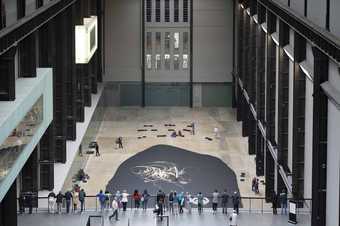
In response to the ‘yang’ energy of the Turbine Hall, the artist designed the shape of the flooring to have a gentler ‘yin’ inkblot shape
Lee Mingwei, Our Labyrinth, 2015-ongoing. Performance view at Tate Modern, 2022. Photograph © Tate 2022 (Photographer: Oliver Cowling)
Gift
Gifts play an important role within Lee’s practice and he repeatedly underscores the sacredness of the act of giving in the happenstances he creates. Lewis Hyde’s The Gift (1983) has been a key text influencing the artist’s practice. Lee summarises its importance; it ‘talks about artists as creators of gifts, and how they are the conduit of the world. I see myself very much in that way.’
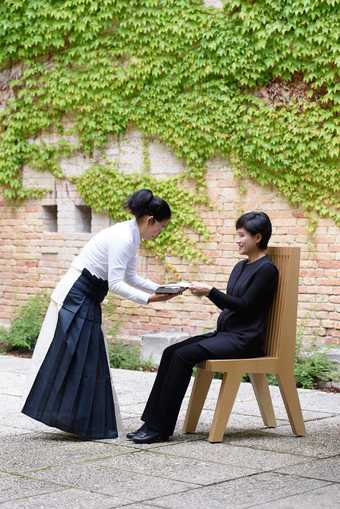
When Beauty Visits, 2017. Viva Arte Viva, The 57th International Art Exhibition - La Biennale di Venezia, Venice, Italy. Photo courtesy of LEE Studio, photo by Anpis WANG
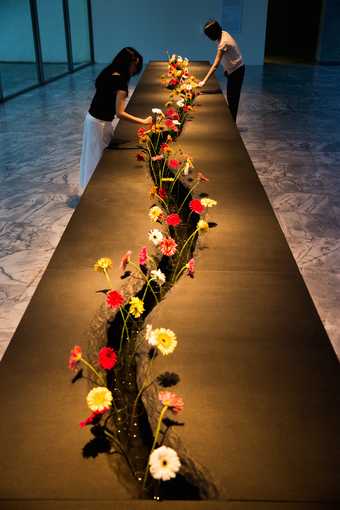
The Moving Garden, 2009 | 2015. Installation view at Lee Mingwei and His Relations: The Art of Participation, Taipei Fine Arts Museum, Taiwan. Photo courtesy of Taipei Fine Arts Museum
Beyond Our Labyrinth several works have been informed by the act of giving. When Beauty Visits (2017) involved participants enjoying the serenity of the Carlo Scarpa Garden at the 2017 Venice Biennale and receiving a gift which they were instructed to open ‘after their next encounter with beauty.’ The artist likewise links chance with the act of giving, which is also experienced in an earlier work titled The Moving Garden (2009-present). On this occasion, visitors were invited to select a flower from a floral display in the gallery and then ‘give the flower to a stranger, who they feel would benefit from this act of generosity.’ Reflecting on the value of this practice, Lee explains ‘as in life, we rarely learn how far our kindnesses (or unkindness) extend… I choose to make it easier for others to be kind, and leave the rest to fate.’
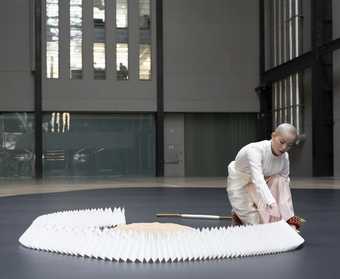
Liu I-Ling opens Our Labyrinth by removing an origami wall which surrounds the mound of rice.
Lee Mingwei, Our Labyrinth, 2015-ongoing. Performance view at Tate Modern, 2022. Photograph © Tate 2022 (Photographer: Oliver Cowling)
In creating Our Labyrinth, Lee creates an opportunity for dancers to provide the gift to the audience. Lee describes how Our Labyrinth ‘is a gift from the dancers to the visitors. It provides a clear space, both physically and spiritually, as they explore the sacred space created by the project’.
One of the dancers Lee repeatedly works with, Jean-Gabriel Manolis, is described as a ‘seed dancer’ who helps transfer the embodied-knowledge of the performance to new dancers. Manolis articulates how the performance – the gift – is created as ‘each dancer is able to bring their own creativity, body, experience, everything they have, into the frame that you create’.
As part of the act of giving, each dancer is guided by their own energy levels to perform. This challenges Western concepts of time and labour. The dancer chooses how they perform – the pace and action – according to how they feel as opposed to enforced choreography dictating their movement. For the visitor, there is an element of chance embedded within the performance - what they see is a gift of the energies of the dancer.
Guided by rice
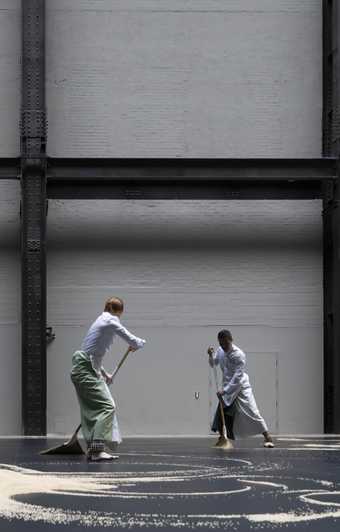
Olivia Thynne and Wu Cheng-Lung respond to each other’s performance.
Lee Mingwei, Our Labyrinth, 2015-ongoing. Performance view at Tate Modern, 2022. Photograph © Tate 2022 (Photographer: Oliver Cowling)
Although Our Labyrinth is usually performed by trained dancers, there is no choreography. Instead, Lee explains that the ‘rice guides them through the dance.’ The dancers therefore create the dance in the moment, requiring an understanding of how to perform movement from interacting with the rice.
Manolis reveals that the instruction Lee gave to him was not ‘to put your own movement into the dance, let the rice move you.’ In sweeping the rice, the broom becomes an extension of the dancer’s body. This is similar to East Asian traditions of calligraphy where the brush becomes an extension of the arm. Working this way, Manolis 'noticed that working with the rice helped me enter a meditative space, and then to cleanse everything through the body and through the mind as well.’
Lee chose rice as a key ingredient of Our Labyrinth which is in keeping with his practice of inviting audiences to focus on something familiar. The work was first staged in 2015 at the Taipei Fine Arts Museum in Taiwan where rice has multiple layers of cultural meaning. Lee explains 'For East Asians, and probably most Asians, rice is sacred. It's food from the heavens. It keeps us alive and keeps the civilization alive. It's also the seed of a plant, so it's a germination, the beginning of something.'
The multiplicity of significance is typical of Lee’s work, as he often allows for many different meanings to be drawn by the audience.
Art made out of attention
Born in 1964, Lee studied textile at California College of Art and sculpture at Yale in the 1990s. From there he developed a practice which often turns to the immaterial and the transient. He asks:
Can art be made out of attention itself? Can art be the attentive performance of simple actions? Can art be the manipulation of attention itself, the bringing of greater awareness to ordinary things, thereby transforming our life and our perceptions of experience of the present, past, and future?
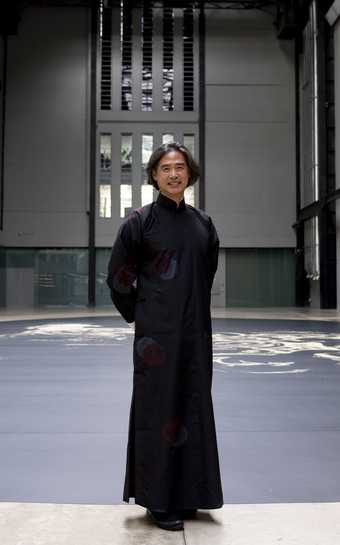
Lee Mingwei. Photograph © Tate 2022 (Photographer: Oliver Cowling)
Rather than attempting to answer these questions definitively, Lee instead chooses to allow these questions to open possibilities and allow for the chance encounter. At the core of these questions is to allow participants the opportunity to focus themselves and derive new meaning from something familiar. The space of the museum can provide an opportunity for visitors to slow down and contemplate these ideas.
Our Labyrinth is intended to be staged for the duration of the gallery’s opening hours. This kind of work is sometimes described as a ‘durational performance’ or ‘endurance art’ which is not defined by a particular timeframe but could be understood as a performance piece lasting for an extended period of time.
One of the values of Our Labyrinth’s long performance times is that it enables different audiences to encounter the work. Some visitors will intentionally arrive in the space having learned about the work before, but for Lee it is equally important for a visitor to come across the work by chance. Equally significant is that ‘the dancers may encounter obstacles along the way, but they will navigate these silently and mindfully.’ These obstacles could be mental or physical, but they can also be reimagined as an opportunity to do something different.
In the Turbine Hall at Tate Modern, for example, the conditions responded to the weather outside so sometimes the dancers adapted to lower light conditions and sometimes it was more humid. A shard of light offered another moment of beauty for those performing and those witnessing. For both the visitor and the dancer, Our Labyrinth offers a period of chance and focus during a visit to the museum. Lee delights in how chance or fate occurs in his work: ‘in my interactions with people, the beauty of chance is what I treasure most.'
Impermanence

Aya Sone and Jean-Gabriel Manolis are seed dancers who have performed Our Labyrinth many times but 2022 is the first time they perform with two dancers at a time.
Lee Mingwei, Our Labyrinth, 2015-ongoing. Performance view at Tate Modern, 2022. Photograph © Tate 2022 (Photographer: Oliver Cowling)
A defining characteristic of Our Labyrinth, and other performance works, is its impermanence, something Lee actively channels within his practice.
Growing up in Taiwan, Lee attended a Chan Buddhist monastery during his summer holidays. In Buddhist teachings, embracing impermanence is a cornerstone of its practice. This can be witnessed in the creation of mandalas: geometric configurations of symbols used as creative method to channel sacred practices. In addition to Buddhism, they are also associated with Hinduism, Jainism and Shintoism. Sand mandalas, for example, are created by Tibetan Buddhist monks who make complex configurations from different colours of sand only for these intricate works of art to then be destroyed. In a similar way, the dancers in Our Labyrinth create patterns from rice which are gathered at the end of their performance. Both artworks demonstrate how the act of creation and destruction underscores impermanence, emphasising the importance of experience in encountering art.
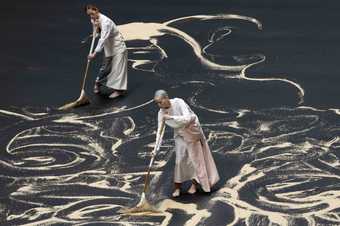
Aya Sone and Liu I-Ling mindfully create labyrinthine spirals together, like galaxies colliding.
Lee Mingwei, Our Labyrinth, 2015-ongoing. Performance view at Tate Modern, 2022. Photograph © Tate 2022 (Photographer: Oliver Cowling)
Our Labyrinth also lives in different locations and can transform in response to the space in which it exists. In 2020, in a collaboration with Bill T. Jones, Our Labyrinth included a sonic landscape provided by three experimental vocalists. Performed at the Met Museum in New York, the performance was livestreamed in response to social distancing during the COVID-19 pandemic.
The edition acquired by Tate could be performed with one dancer at a time. For its 2022 presentation at Tate Modern, however, Lee expanded the performance to two dancers performing at a time. This was in response to the large space of the Turbine Hall and was based on the artist having observed two dancers moving together during a rehearsal for a previous presentation. Lee imagined an expanded version of Our Labyrinth, reflecting that the two dancers ‘might collide slowly as if they were galaxies in the celestial sky, slowly evolving and engaging with each other and then separating when time comes. It would be quite magical.'
Research supported by Hyundai Tate Research Centre: Transnational in partnership with Hyundai Motor
Our Labyrinth was presented in the Turbine Hall at Tate Modern 26 May – 15 June 2022. It was performed by Ben Ajose-Cutting, Iris Athanasiadi, Rosalie Bell, Yen-Ching Lin, Liu I-Ling, Jean-Gabriel Manolis, Thomas McKeon, Aya Sone, Olivia Thynne, and Wu Cheng-Lung.
These performances were supported by the Performance Activation Fund: Catherine Petitgas, Tate International Council, Tate Patrons and Tate Members; Ministry of Culture, Taiwan; and Tate Asia-Pacific Acquisitions Committee.

